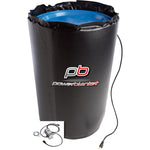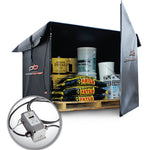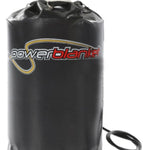You have no items in your shopping cart.
The Crucial Role of Temperature in Concrete Curing
Article At-a-Glance
What is the Optimal Temperature for Curing Concrete?
The ideal temperature range for curing concrete is between 50 and 70 degrees Fahrenheit, as this range ensures the optimal chemical reactions necessary for strength and durability, while strategies like using insulating blankets can help maintain these conditions in varying weather.
Key Takeaways
- Optimal Temperature Range: Concrete cures best between 50 and 70 degrees Fahrenheit, ensuring the necessary chemical reactions for maximum strength and durability.
- Temperature Effects: Low temperatures can halt hydration, weakening concrete, while high temperatures can cause rapid moisture loss, affecting strength development.
- Cold Weather Strategies: Use insulating blankets and heated enclosures to maintain suitable curing temperatures and prevent freezing in cold conditions.
- Hot Weather Solutions: Implement continuous water curing and sunshades to manage rapid curing and moisture loss in hot climates.
- Long-term Durability: Proper temperature management during curing enhances concrete's resistance to environmental stressors, ensuring longevity and structural integrity.
Curing concrete is a critical process in the construction industry, directly impacting the strength and durability of concrete structures. The concrete curing temperature plays a pivotal role in ensuring the concrete cures properly, achieving its maximum potential in terms of strength and longevity.
The Fundamentals of Concrete Curing Process
Successful concrete curing is maintaining adequate moisture, temperature, and time to allow the concrete to achieve its desired properties. Proper curing is essential for the chemical reaction that strengthens concrete, making it considerably stronger and more durable. Allowing the concrete to withstand cold weather or hot weather extremes without breaking down.
The Ideal Concrete Curing Temperature
The temperature significantly influences the rate and effectiveness of the curing process. The ideal concrete curing temperature typically ranges between 50 and 70 degrees Fahrenheit. This range facilitates the optimal chemical reactions necessary for strengthening the concrete. The ideal temperature to allow concrete to cure effectively isn't just referencing the temperature of the concrete but also considering what the best temperature conditions would be to result in the strongest and most durable concrete. The focus should be on maintaining the internal concrete temperature in this range rather than just ambient temperatures.

$1,279.99 USD
5’ x 10’ Multi-Duty Thawing & Concrete Curing Blanket (120V)
Challenges in Different Weather Conditions
Curing Concrete in Cold Weather
Cold weather poses significant challenges to curing concrete. Cold temperatures, especially temps below freezing, can halt the hydration process, leading to weaker concrete. To combat this, insulating blankets and other protective measures are essential to maintain a suitable curing temperature.
Curing Concrete in Hot Weather
Conversely, hot weather accelerates the curing process, which can lead to rapid moisture loss and inadequate strength gain. Continuous curing and moisture retention strategies are crucial in these conditions to prevent the concrete from curing too quickly.
The Science Behind Concrete Curing
The curing operation involves complex chemical reactions, primarily hydration, where water molecules react with cement. Temperature plays a crucial role in these reactions, directly impacting the rate of strength gain in the concrete.
Why Temperature Matters
The temperature of the concrete impacts the rate of hydration reactions. Higher concrete temperatures speed up the reactions considerably. However, too high leads to other defects. Maintaining the optimal concrete temperature range enables strength gain without issues.
Here is a table summarizing the effects of elevated temperature on the compressive strength of grade 40 concrete at 7 days and 28 days:
| Temperature (°C) | Average Compressive Strength (MPa) - 7 days | % Decrease from 24°C - 7 days | Average Compressive Strength (MPa) - 28 days | % Decrease from 24°C - 28 days |
|---|---|---|---|---|
| 24 (Reference) | 37.6 | 0% | 49.0 | 0% |
| 100 | 33.5 | 10.9% | 41.9 | 14.5% |
| 150 | 30.3 | 19.4% | 36.5 | 25.5% |
| 200 | 26.5 | 29.5% | 31.6 | 35.5% |
| 250 | 23.3 | 38.0% | 27.5 | 43.9% |
| 300 | 19.7 | 47.6% | 22.8 | 53.5% |
Practical Tips for Curing Concrete
Preparing for the Concrete Pour
Successful concrete curing starts with preparation. Understanding the concrete mix and adjusting it based on the ambient temperature can significantly impact the curing process. Before pouring concrete, it's essential to consider the current and expected weather conditions. In hot weather, the ratio might require adjustments, such as adding chilled water or ice to reduce the initial concrete temperature.

Conversely, in cold weather, using hot water in the mix or increasing the amount of Portland cement can help maintain the right temperature for curing. It's also crucial to have all necessary tools and materials, like insulating blankets or curing compounds, ready beforehand, especially in extreme weather conditions.
The preparation phase also involves ensuring that the subgrade is ready to support the fresh concrete. This means it should be moist but not waterlogged. Pouring concrete on a dry subgrade can lead to too much water being absorbed from the mix, negatively affecting the hydration process. Additionally, the concrete mix design should consider factors like the aggregate size and the specific type of Portland cement used, as these can influence the concrete's setting time and its response to the curing process.
Letting Concrete Cure Properly
During curing, monitoring the concrete's temperature and adjusting the curing time accordingly is vital. The temperature of the concrete should be kept within a specific range to ensure optimal curing. In cold weather, methods like heated enclosures or insulated blankets can be used to maintain the temperature, preventing the concrete from freezing. In hot conditions, measures such as continuous water curing or sunshades can help control the temperature.
Maintaining the right moisture levels is also crucial to prevent the concrete from drying out too quickly. This can be achieved through ponding, wet coverings, or curing compounds that form a moisture-retaining film over the surface. Continuous curing is essential, as even short periods of inadequate moisture or temperature can significantly reduce the strength of the concrete whereas moisture and temperature control creates a scenario where the concrete gains strength. It's important to remember that the curing time can vary based on factors like the type of cement used, the mix proportions, and the ambient temperatures. Generally, at least seven days is recommended for most concrete mixes under moderate temperatures.
After the Concrete Has Cured
After the curing is complete, assessing the concrete's strength development is essential. Various factors, including the curing temperature and duration, affect the final strength and durability of the concrete. Compressive strength tests can be conducted to ensure that the concrete has reached the desired strength. It's important to note that concrete continues to gain strength beyond the initial curing period, especially if it is kept moist and at the right temperature.
The final strength and quality of the concrete also depend on how well it was protected and cured during the initial stages. Inadequate curing can lead to issues like surface cracking and reduced durability. Factors like the average daily air temperature during the curing period and the effectiveness of the curing methods used play a significant role in the final outcome. Properly cured concrete not only achieves its maximum strength but also exhibits improved resistance to cold-weather more specifically freeze-thaw cycles and deicing chemicals, making it more durable over its lifespan. Therefore, the post-curing assessment is crucial in determining the success of the curing and the long-term performance of the concrete structure.
Advanced Techniques and Considerations
Over the years, the construction industry has seen a variety of advanced techniques in concrete curing, each addressing specific environmental challenges and project requirements. Historically, methods have ranged from traditional wet curing to the use of additives in the concrete mix to accelerate the hydration process. However, a significant breakthrough in this field has been the development and use of concrete curing blankets, which have revolutionized the way concrete is cured, especially in adverse weather conditions.
Curing blankets are designed to offer an efficient and controlled curing environment. These specialized blankets are known for their ability to cure concrete up to 2.8 times faster than traditional methods. This accelerated curing is particularly beneficial in regions with poor weather conditions, where maintaining the right curing temperature and moisture levels can be challenging. The blankets work by insulating the concrete, retaining heat and moisture, and thus creating an optimal curing environment. This controlled environment ensures that the hydration process continues effectively, regardless of external weather conditions.

The use of these blankets is not just about speed; it also impacts the quality of the cured concrete. Studies and practical applications have shown that concrete cured under these blankets tends to be stronger and more durable. This strength enhancement is attributed to the more consistent and efficient hydration process facilitated by the blankets. They help in maintaining a steady temperature, which is crucial for the chemical reactions involved in the concrete strength development during curing. This consistency results in a more uniform and stable concrete structure, reducing the likelihood of defects such as cracking or spalling.
In addition to curing blankets, other advanced techniques include the use of admixtures and accelerants in the concrete mix. These chemical additives are used to speed up the setting time and the strength development in concrete, which is particularly useful in time-sensitive projects or in conditions where the ambient temperature is not conducive to natural curing processes. However, the choice of additives must be made carefully, considering the specific requirements of the project and the long-term behavior of the concrete.
Another consideration in advanced curing techniques is the use of controlled steam curing, particularly in precast concrete operations. This method involves exposing the concrete to steam at controlled temperatures and pressures, accelerating the process of curing and achieving significant strength gains in a shorter period. While effective, this method requires specialized equipment and careful monitoring to ensure the quality and integrity of the concrete.
In conclusion, while traditional methods of curing concrete have their place, the advent of concrete curing blankets and other advanced techniques offer significant advantages in terms of speed, efficiency, and final concrete quality. These innovations are particularly valuable in challenging weather conditions, ensuring that projects can proceed without delays while still achieving superior concrete strength and durability.
Mastering the Art of Concrete Curing at Optimal Temperatures
Curing concrete at the right temperature is a delicate balance that requires careful planning and execution. By understanding the science behind the process and implementing practical strategies, one can ensure the strength and durability of concrete structures.













